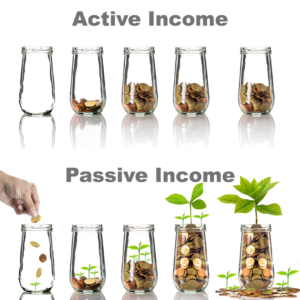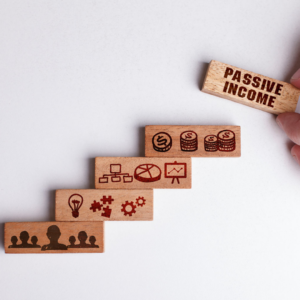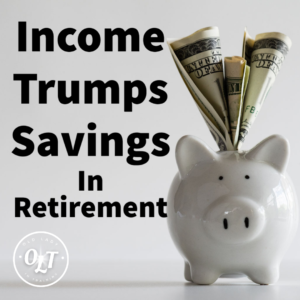Welcome to another enlightening post on the “Old Lady in Training” blog. Today, we’re going to delve into the world of dividend investing to create passive income for retirement, a topic that might sound complex at first, but trust me, it’s simpler than you think and can be a game-changer for your financial future.
So, what’s the buzz about dividend investing? Well, it’s a strategy that focuses on buying stocks from companies that distribute a portion of their earnings back to their shareholders in the form of dividends. Think of it as a thank you note from the company for investing in them. But the best part? These dividends can provide you with a steady stream of passive income for retirement, making it a fantastic tool for building a passive income strategy.

Why is this relevant to you? In the hustle and bustle of our daily lives, who wouldn’t want an additional income stream that requires little to no effort to maintain? That’s the beauty of passive income for retirement, and dividend investing can play a crucial role in achieving it.
In this post, we’ll demystify dividend investing, explore its benefits, and guide you on how to incorporate it into your passive income strategy. Whether you’re a seasoned investor or just starting your financial journey, there’s something in here for everyone. So, let’s dive in and start building a stronger financial future together!
What is Dividend Investing?
If you’re new to the world of investing, you might be wondering, “What exactly is dividend investing?” Well, let’s break it down.
Dividend investing is an investment strategy that focuses on purchasing stocks from companies that regularly pay dividends. But what are dividends? They are a portion of a company’s profits that are distributed to its shareholders. It’s like getting a slice of the company’s success pie!
There are two main types of dividends:
Cash Dividends: This is the most common type of dividend. As the name suggests, cash dividends are cash payments made to the shareholders of the company. The amount you receive depends on the number of shares you own. For example, if a company declares a cash dividend of $1 per share and you own 100 shares, you’ll receive $100.
Stock Dividends: Instead of cash, some companies choose to distribute additional shares of stock to their shareholders. This increases the number of shares you own, which can potentially increase your total dividends in the future.

Dividend investing is a long-term strategy. The goal is to build a portfolio of dividend-paying stocks that will provide you with a steady stream of income over time. This income can be used to cover living expenses, reinvested to purchase more shares, or saved for future needs.
In the next sections, we’ll explore why dividend investing is a smart move and how it can contribute to your passive income for retirement strategy. Stay tuned!
Why Dividend Investing?
Now that we’ve covered the basics of what dividend investing is, let’s delve into why it’s a strategy worth considering. Dividend investing offers several benefits that can contribute to your financial growth and stability.
Regular Income: One of the most attractive aspects of dividend investing is the potential for regular income. Companies that pay dividends usually do so on a regular schedule (quarterly, semi-annually, or annually). This means you can look forward to regular payments, much like receiving a paycheck, which can be particularly beneficial if you’re looking for a steady income stream in retirement.
Potential for Capital Appreciation: While the dividends are a significant part of dividend investing, they aren’t the only way you can earn money. If the company you’ve invested in performs well, the value of the stock can increase over time. This means that when you decide to sell your shares, you could make a profit from the increased stock price.
Reinvestment Opportunities: Dividends provide an excellent opportunity for reinvestment. Many companies offer Dividend Reinvestment Plans (DRIPs), which automatically use your dividends to purchase more shares of the company’s stock. This can be a powerful way to increase your holdings and potentially boost your future dividends.
A Part of Passive Income Strategy: Dividend investing fits perfectly into a passive income strategy. Once you’ve done the initial work of researching and purchasing the stocks, the dividends can provide you with income without any additional effort on your part. It’s a way to make your money work for you.
 In the following sections, we’ll dive deeper into how to get started with dividend investing, understand key metrics, and manage the associated risks. So, keep reading!
In the following sections, we’ll dive deeper into how to get started with dividend investing, understand key metrics, and manage the associated risks. So, keep reading!
Understanding Dividend Yield and Dividend Payout Ratio
Before you dive headfirst into dividend investing, it’s crucial to understand some key metrics that can help you make informed decisions. Two of the most important are the dividend yield and the dividend payout ratio.
Dividend Yield: The dividend yield is a financial ratio that shows how much a company pays out in dividends each year relative to its stock price. It’s usually expressed as a percentage. The dividend yield can give you an idea of the return you can expect from the dividend alone. For example, if a company’s stock is priced at $100 per share and it pays out $5 in dividends per year, the dividend yield is 5%.
However, a high dividend yield isn’t always a good thing. It could be a sign that the company’s stock price has fallen. As with all aspects of investing, it’s important to look at the whole picture and not base your decisions on a single metric.
Dividend Payout Ratio: The dividend payout ratio is another important metric. It shows the portion of the company’s earnings that is paid out as dividends. This is usually expressed as a percentage. For example, if a company earns $1 per share and pays out 50 cents in dividends, the dividend payout ratio is 50%.
A lower payout ratio could mean that the company is retaining more earnings for growth, while a higher payout ratio could indicate that the company is committed to returning profits to shareholders. However, a very high payout ratio could also mean that the company isn’t reinvesting enough in its own growth.
Understanding these metrics can help you evaluate potential dividend stocks and make informed decisions about where to invest your money. In the next section, we’ll discuss how to start dividend investing and build a diversified portfolio.
How to Start Dividend Investing
Starting your journey into dividend investing might seem daunting, but it doesn’t have to be. Here are some steps to guide you:
Step 1: Set Your Financial Goals Before you start investing, it’s important to understand your financial goals. Are you investing for retirement, to generate passive income, or for another reason? Knowing your goals can help guide your investment decisions.
Step 2: Choose a Brokerage To buy stocks, you’ll need to open an account with a brokerage. There are many brokerages to choose from, each with its own set of fees, services, and investment options. Do your research to find one that fits your needs and comfort level.
Step 3: Research Potential Dividend Stocks Once you have a brokerage account, it’s time to start researching potential investments. Look for companies with a history of stable dividend payments and growth. Remember to consider the dividend yield and payout ratio, but also look at the company’s overall financial health and business prospects.
Step 4: Diversify Your Portfolio Don’t put all your eggs in one basket. Investing in a variety of companies and sectors can help protect you from risk. If one stock performs poorly, others might perform well and balance out your losses.
Step 5: Reinvest Your Dividends Consider reinvesting your dividends to buy more shares. This can help you grow your portfolio and potentially increase your future dividends.
Step 6: Monitor Your Investments Investing isn’t a set-it-and-forget-it activity. Regularly review your portfolio to ensure it’s still aligned with your financial goals. You might need to make adjustments as market conditions change or as you get closer to your goals.
 Remember, investing always comes with risks, and it’s possible to lose money. But with careful planning and research, dividend investing can be a powerful tool for generating passive income and growing your wealth. In the next section, we’ll discuss some of the risks involved in dividend investing and how to manage them.
Remember, investing always comes with risks, and it’s possible to lose money. But with careful planning and research, dividend investing can be a powerful tool for generating passive income and growing your wealth. In the next section, we’ll discuss some of the risks involved in dividend investing and how to manage them.
Risks Involved in Dividend Investing
While dividend investing can be a profitable strategy, it’s important to be aware of the potential risks involved. Understanding these risks can help you make more informed decisions and potentially avoid costly mistakes.
Market Risk: Like all investments, dividend stocks are subject to market risk. This is the risk that the overall market will decline, which can lead to a decrease in the value of your stocks. Diversifying your portfolio can help mitigate this risk.
Company Risk: There’s always a risk that a company will perform poorly, leading to a drop in its stock price or a cut in its dividends. This is why it’s important to research companies thoroughly before investing and to monitor your investments regularly.
Interest Rate Risk: Dividend stocks can be sensitive to changes in interest rates. When interest rates rise, the value of dividend stocks can decline. This is because investors may move their money to bonds or other investments that offer a higher return.
Dividend Cut Risk: Companies are not obligated to pay dividends, and they may choose to reduce or eliminate their dividend payments if they face financial difficulties. This can lead to a decrease in your income from dividends.
Inflation Risk: If the rate of inflation is higher than the return on your investments, your purchasing power can decrease. This means that even though you’re earning income from dividends, it may not be enough to keep up with the rising cost of living.
Despite these risks, dividend investing can still be a valuable part of a balanced investment strategy. The key is to do your homework, diversify your investments, and stay informed about market conditions. In the next section, we’ll compare dividend investing with other investment strategies to help you decide if it’s right for you.
Dividend Investing vs. Other Investment Strategies
As you navigate your investment journey, it’s important to understand that dividend investing is just one of many strategies you can use to grow your wealth. Let’s take a moment to compare it with a couple of other popular strategies:
Growth Investing: Growth investors focus on companies that they believe have above-average potential for growth in revenue and earnings. These companies often reinvest their earnings back into their business rather than paying dividends. While growth investing can offer higher potential returns, it also comes with a higher level of risk compared to dividend investing. 
Value Investing: Value investors seek out companies that they believe are undervalued by the market. These companies often have lower price-to-earnings (P/E) ratios and may pay dividends. While value investing can offer a margin of safety, it requires a good understanding of financial analysis and a willingness to go against market trends.
Income Investing: Income investors seek out investments that generate regular income. This can include dividend stocks, but also bonds, real estate investment trusts (REITs), and other income-generating assets. Dividend investing can be a part of an income investing strategy.
Each of these strategies has its own strengths and weaknesses, and the best one for you depends on your financial goals, risk tolerance, and investment timeline. Dividend investing can be a good fit if you’re looking for a strategy that can provide regular income and potential for capital appreciation, and if you’re comfortable with the risks associated with investing in stocks.
We’ve covered a lot of ground in this post, from understanding what dividend investing is to exploring its benefits and risks. We’ve also compared it with other investment strategies to give you a broader perspective.
Dividend investing can be a powerful tool in your investment arsenal. It offers the potential for regular passive income for retirement, capital appreciation, and reinvestment opportunities, making it an ideal strategy for generating passive income. However, like all investment strategies, it’s not without risks. It’s important to do your research, diversify your portfolio, and regularly review your investments.
Additional Resources
Congratulations on making it to the end of this post! You’ve taken a big step towards understanding dividend investing and how it can fit into your passive income strategy. But remember, learning is a lifelong journey. If you’re interested in diving deeper into this topic, here are some additional resources you might find helpful:
- Books:
- Online Courses:
- “Investing In Stocks The Complete Course!” on Udemy
- “Dividend Investing Masterclass” on Skillshare
- Websites/Blogs:
- Dividend.com: A comprehensive resource for dividend-related news, strategies, and stocks.
- The Motley Fool: Offers a wealth of information on investing, including articles on dividend stocks.
- Podcasts:
- “The Dividend Guy Blog” by Mike Heroux: Offers practical advice and strategies on dividend investing.
- “Investing for Beginners Podcast” by Andrew Sather and Dave Ahern: Covers a wide range of investing topics, including dividends.
Remember, the key to successful investing is continuous learning and staying informed about market trends and changes. We wish you all the best on your investing journey! 
Remember, investing is a journey, not a destination. It’s about making consistent, informed decisions that align with your financial goals. Whether you’re just starting out or looking to diversify your investment portfolio, dividend investing can be a worthwhile strategy to explore.
Thank you for joining us on this exploration of dividend investing. We hope you found it informative and helpful. As always, we’re here to support you on your financial journey. Stay tuned for more insightful posts on investing and personal finance!